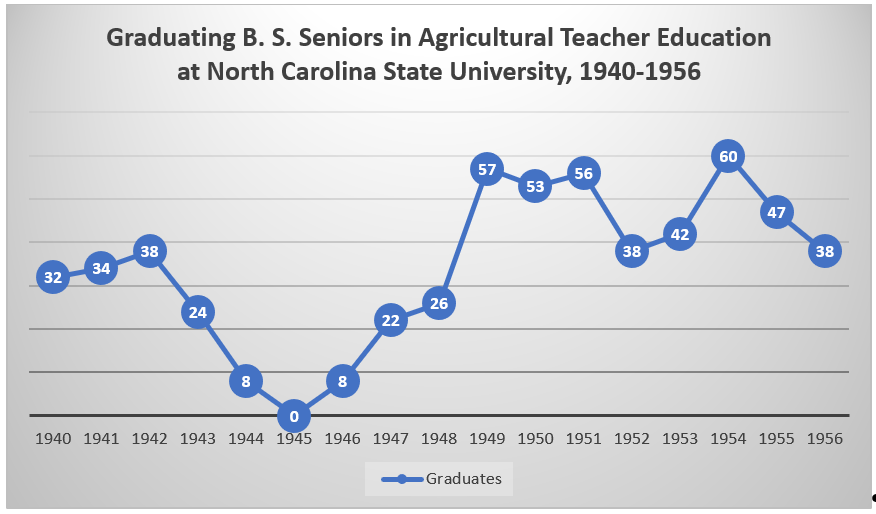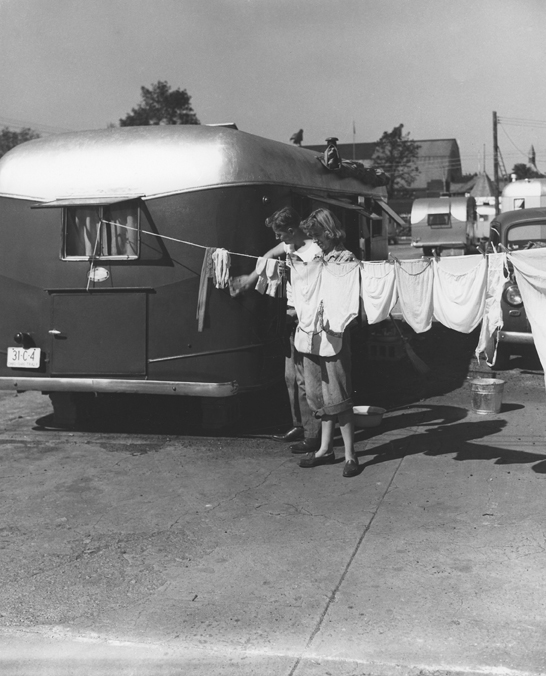A few weeks ago the Friday Footnote (7/12/2019) focused on how the GI Bill (officially the Servicemen’s Readjustment Act) enabled World War II veterans to enroll in the Institutional On-Farm Training Program. This was a program where returning veterans took vocational agriculture classes at their local high schools, typically at night. Nearly 700,000 veterans availed themselves of this educational opportunity.
The G.I. Bill also allowed veterans to enroll in college. Some 2,230,000 veterans chose to do this. The veterans could pick any major and many chose to major in agriculture, including agricultural teacher education. The following graph shows the number of agricultural education students who graduated with B.S. degrees between 1940 – 1956 at North Carolina State University.

Several points should be made about the graph. The number of graduates between 1940-1942 were 32, 34 and 38. However, as America became more involved in the war the number of graduates declined. In 1945 there were no graduates and that is primarily because most of the students had entered the service and/or returned to the farm to produce food (the first Ag Ed graduating class at NCSU was in 1918 and there have been graduates every year since, except for 1945).
It should be obvious by looking at the graph when the war ended students started taking advantage of the college provision of the G.I. Bill. Student enrollment ticked up in 1946 and continued to climb in the years that followed. This can be attributed primarily to the G. I. Bill. The benefits of the G.I. Bill for WWII vets ended in 1956.
Similar trends were occurring in agricultural teacher education programs across the country. The increased enrollments in agricultural teacher education and all the other university majors created major management problems for universities. Slightly over 49% of college enrollments in 1947 were veterans. This was known as the G.I. Bulge. At some universities, enrollments of veterans were even higher. At North Carolina State University it was 76%.
The University of Michigan grew from 10,000 students before the war to 30,000 students in 1948 (Haydock, 1999). Syracuse University grew from 6,000 students before the war to 19,000 in 1947. Rutgers went from 7,000 students to 16,000. At Lehigh University in Pennsylvania, the 940 veterans on campus outnumbered the 396 “civilians.” At the University of Missouri, there were 2,800 students in September of 1945 – fast forward to October of 1946 – 10,585 students,
The big influx of students created housing problems and academic problems (finding classroom space and qualified teachers). A number of creative approaches were used to house the students. Some universities brought in Quonset huts, prefabricated housing, war surplus wooden barracks, and even travel trailers. Before these structures arrived, the veterans camped out in gyms, auditoriums and other unoccupied spaces. While not ideal, it was much better than what they had experienced during the War.
The University of Missouri had a Dairylawn Trailer Park and a Fairway Village Trailer Park. The University also disassembled 66 war surplus barracks from military bases, some from Fort Leonard Wood, and reconstructed them on campus. The photo below is Fairway Village at the University of Missouri.

At Ohio State, a Veterans Village comprised of trailers was created on Olentangy River Road. An additional 185 trailers were parked at the state fairgrounds. Veterans also lived under the west side of Ohio Stadium (the football stadium). Barracks which could house 810 men were also built on campus. The photo below is from the fairgrounds trailer park.

At North Carolina State there were two veteran villages. One was known as Trailwood and was comprised of travel trailers. Vetville had a variety of buildings including barracks, cottages, and Quonset huts. Vetville had an elected student mayor, a grocery store, and a YMCA. There was even a cooperative nursery know as Totville.

These are just a few examples. Many other universities did the same thing. The Quonset huts were supposed to be temporary, but many were used for 40 or more years for a variety of purposes. Some may still exist today. The photo below is of the Vet Village at Oklahoma State. The 2nd photo is from Iowa State. and shows Quonset huts, trailers and temporary buildings.


How did universities handle the big influx of students academically? Haydock (1999) provided several examples of what was done:
At the University of Pittsburgh, there were so many students that classes had to be held on both a day and a night schedule. At Iowa State University too, classes began at 7:30 a.m. and went until 10:30 at night. The University of Florida, where enrollment jumped 155 percent, conducted a 61-hour academic week.
Haydock (1999) also reported that finding enough faculty to teach the classes was a challenge:
The wives of Ohio State faculty members were enlisted to aid their spouses in teaching and Iowa’s College of Liberal Arts hired 91 new instructors, more than a third of them with no previous teaching experience and most under 32 years of age. When a Harvard professor of philosophy, who normally instructed groups of ten, found his classroom overflowing, he promptly left, thinking that he had somehow wandered into a required “Freshman English” course.
Some university administrators were wary of having returning veterans as students. The President of the University of Chicago (Hutchens, 1994) wrote that “Colleges and universities will find themselves converted into educational hobo jungles . . . ..The president of Harvard was concerned that “we may find the least capable among the war generation . . . flooding the facilities for advanced education.”
A few educators believed that their added maturity and greater sense of purpose and social consciousness would make the returnees exceptional students, but most viewed their presence on campus with anxiety. Some predicted that the veterans would, as a result of their military experience, reject discipline, rebel against authority, lack initiative, and suffer from restlessness and hostility.
However, it was not long before the college administrators changed their tune. A professor at Lehigh spoke for most of his colleagues when he stated: “The civilian kids consider most of us doddering imbeciles. But the veterans seem to be impressed with our knowledge. They are old enough to realize that they know very little.” He added that “They are the most responsive and receptive students Lehigh has ever had.” One non-veteran student at Lehigh complained that the veterans “work so hard, we have to slave to keep up.”
Even President Conant of Harvard changed his mind about veterans as students. In an article in Life magazine, he admitted that “for seriousness, perceptiveness, steadiness, and all other undergraduate virtues,” the former soldiers and sailors were “the best in Harvard’s history.” At Columbia University in ’47, none of the 7,826 veterans in attendance was in serious academic difficulty. Such performances were the norm on campuses across the country (Haydock, 1999).
There were some “cultural clashes.” For decades the freshman at Lehigh University had been required to were brown socks, a brown tie, and a beanie. If a freshman violated this policy, the Junior Vigilante Committee would punish the student. The veterans chose to ignore that tradition. What junior is going to challenge a veteran who had fought at Normandy or Iwo Jima? Even after the student newspaper ran an editorial extolling the virtues of such traditions, the veterans continued to be in non-compliance (Haydock, 1999).
Most veterans refused to put up with the traditional collegiate hazing which hastened the demise of these rituals. On a national level, the Interfraternity Council worried about decreasing membership figures for Greek organizations. On a few campuses, WWII veterans formed an informal fraternity called Chi Gamma Iota, the Greek letters for “X-G-I.”
The library at NCSU has an online exhibit about the G.I. Bill Experience at NC State. You are encouraged to peruse it. https://www.lib.ncsu.edu/archivedexhibits/gibill/.
Concluding Remarks
The influx of veterans on college campuses after World War II created challenges. But it also benefitted agricultural education. Many agricultural teacher education programs across the country experienced record-setting enrollments after World War II. This was crucial for the future of agricultural education because many high school programs had been closed during World War II because of the lack of teachers. The large number of potential agriculture teachers attending college on the GI Bill permitted the closed programs to reopen. This is part of our history.
References
“The GI Experience at NC State Exhibition, “North Carolina State University Special Collections Research Center website.
Michael D. Haydock “The GI Bill,” American History Magazine, Originally Published Oct. 1999, Web Published on “The History Net.”
